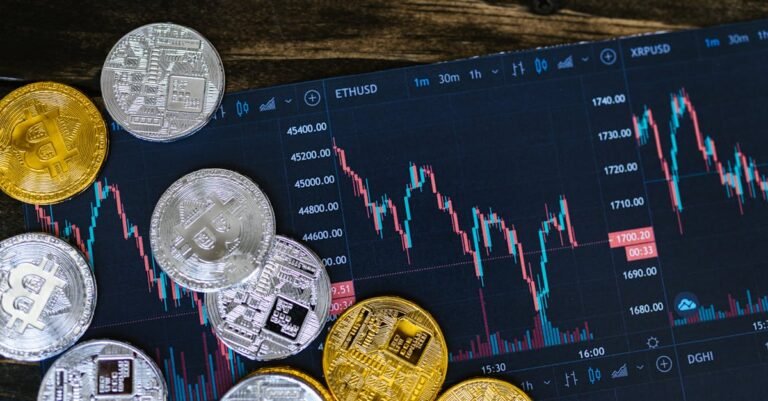How to Analyze Altcoin Market Trends Like a Pro (Even if You’re a Beginner!)
Ever feel like the crypto world, especially the wild west of altcoins, is moving at lightning speed? One minute everyone’s talking about dog themed coins, the next it’s all about artificial intelligence or gaming tokens. It can feel overwhelming, like trying to catch smoke with your bare hands. But what if I told you there’s a way to make sense of the madness? What if you could learn to spot potential winners and understand the forces driving those crazy price swings? That’s exactly what we’re diving into today. Forget complex jargon and confusing charts for a moment. We’re going to break down how to analyze altcoin market trends in a way that actually makes sense, even if you’re just starting out. Think of this as your friendly guide to navigating the exciting, sometimes scary, but potentially rewarding world of altcoins. We’ll explore the tools, the mindset, and the strategies you need to start looking at the market with clearer eyes. Ready to peek behind the curtain?
Understanding the Altcoin Landscape: More Than Just Bitcoin Clones
Okay, first things first. What exactly *are* altcoins? Simply put, an altcoin is any cryptocurrency that isn’t Bitcoin. Think of Bitcoin as the OG, the big boss. Everything else, from Ethereum (the second biggest) down to tiny projects you’ve maybe never heard of, falls under the umbrella of “alternative coins” or altcoins. Now, it’s super important to get this: altcoins are NOT all the same. Calling them all “Bitcoin clones” is like saying every type of fruit is just an apple. The altcoin market is incredibly diverse, a whole universe of different ideas, technologies, and goals.
You’ve got different categories, like:
- Layer 1 Blockchains: These are the fundamental networks, the base layers upon which other applications can be built. Think of them like the operating system for crypto. Examples include Ethereum, Solana, Cardano, Avalanche. They compete on speed, security, and decentralization. Analyzing trends here often involves looking at technological upgrades, developer adoption, and transaction fees. A major upgrade coming to a Layer 1 can sometimes kick off a positive trend for its entire ecosystem.
- Layer 2 Scaling Solutions: Because some Layer 1s (like Ethereum) can get slow and expensive, Layer 2s are built *on top* of them to make transactions faster and cheaper. Examples include Polygon, Arbitrum, Optimism. Trends here are often tied to the success and congestion of their underlying Layer 1, as well as their own specific technology and adoption rates. If Ethereum gas fees are sky high, people naturally look towards Layer 2 solutions, potentially driving their price up.
- DeFi (Decentralized Finance) Tokens: These are related to projects aiming to recreate traditional financial services (lending, borrowing, trading) but without banks or intermediaries. Think Uniswap, Aave, MakerDAO. Analyzing DeFi trends means looking at the Total Value Locked (TVL) in their protocols (how much money people trust them with), the specific financial services they offer, interest rates, and regulatory news, which can heavily impact this sector. A new, innovative lending protocol might see its token trend upwards if it attracts significant capital.
- NFT (Non Fungible Token) and Metaverse Tokens: These are tied to digital collectibles, art, virtual land, and gaming. Examples include Axie Infinity, Decentraland, The Sandbox, ApeCoin. Trends here are often driven by hype, celebrity endorsements, partnerships with big brands, and the overall popularity of specific games or NFT collections. The success of a hit blockchain game can cause its associated tokens to surge.
- Memecoins: Yes, the infamous coins often based on internet jokes or memes, like Dogecoin or Shiba Inu. These are highly speculative and driven almost entirely by social media hype, community buzz, and sometimes, tweets from influential figures. Analyzing memecoin trends is less about fundamentals and more about tracking social sentiment and viral potential. They are incredibly risky.
- And many more niches: Privacy coins, oracle networks (like Chainlink) that feed real world data to blockchains, storage solutions, AI related tokens, Real World Asset (RWA) tokens… the list goes on and keeps growing!
Understanding these categories is crucial because trends often happen within specific sectors. You might see DeFi tokens booming while Metaverse tokens are lagging, or Layer 1s might be in favor while Layer 2s consolidate. This is often driven by “narratives” – the popular stories or themes that capture the market’s attention at a particular time. Maybe there’s a breakthrough in AI, and suddenly all AI related crypto projects get a boost. Or perhaps regulators make positive statements about DeFi, causing that sector to rally. Recognizing these narratives is a key part of analyzing altcoin trends.
Why do altcoin trends often differ so much from Bitcoin’s? While Bitcoin is the king and its movements heavily influence the entire market (if Bitcoin crashes, altcoins usually crash harder), altcoins have their own dynamics. They are generally much more volatile. A small amount of buying pressure can send a low market cap altcoin soaring (or crashing). Market capitalization (market cap) is simply the total value of all the coins in circulation (Coin Price x Circulating Supply). Altcoins range from large caps (like Ethereum) to mid caps, small caps, and even micro caps. Smaller cap coins have more room for explosive growth but also carry significantly higher risk.
Another key difference is their relationship with Bitcoin’s dominance. Bitcoin Dominance (BTC.D) is the percentage of the total crypto market capitalization that belongs to Bitcoin. When BTC.D is rising, it often means money is flowing into Bitcoin, possibly out of altcoins. When BTC.D is falling, it can signal the start of an “altseason” – a period where altcoins tend to outperform Bitcoin. Watching BTC.D can give you clues about the overall market sentiment towards altcoins versus Bitcoin.
But analyzing altcoins isn’t just about spotting the next big narrative or timing altseason. It’s also about being acutely aware of the risks. Many altcoin projects fail. Some are outright scams (rug pulls) where developers disappear with investors’ money. Others simply have flawed technology or tokenomics (the economics of the coin) that prevent long term success. Because many altcoins are relatively new, they lack the long track record and established infrastructure of Bitcoin. Their liquidity (how easily you can buy or sell without affecting the price) can also be much lower, making it harder to get in or out of positions, especially large ones.
So, before you even think about specific analysis tools, internalize this: the altcoin market is a diverse, rapidly evolving space driven by technology, narratives, and yes, a lot of speculation. Understanding the different types of altcoins, their relationship with Bitcoin, the concept of market cap, and the inherent risks is your foundational step. It’s about knowing the playground before you start playing the game. Think about sector rotation – just like in traditional stock markets, money often flows from one crypto sector to another. Maybe profits from a DeFi rally move into NFT projects next, or perhaps Layer 1s cool off and Layer 2s heat up. Being aware of these potential rotations, driven by news, tech advancements, or changing narratives, is vital for analyzing trends effectively. Don’t just look at individual coins in isolation; consider the health and momentum of their specific sector within the broader crypto market. This contextual understanding forms the bedrock of solid altcoin market trend analysis.
Your Altcoin Analysis Toolkit: Fundamental Deep Dives
Alright, now that we have a better feel for the altcoin jungle, how do we actually start analyzing specific projects and their potential trends? One of the most important approaches is Fundamental Analysis (FA). Don’t let the name scare you; it basically means looking at the underlying value and long term potential of a project, kind of like investigating a company before buying its stock. With altcoins, you’re not looking at profit reports in the same way, but you *are* looking at the core factors that could make a project succeed or fail. It’s about asking: Is this project actually useful? Is it well run? Does its coin have a real purpose? Getting these answers helps you understand if a current trend is just hype or if it has legs for the long run.
Think of FA as being a detective. You need to gather clues from various sources to build a case for (or against) an altcoin’s potential. Here are the key areas you need to investigate:
- The Project Team and Vision: This is HUGE. Who are the people behind the project? Do the founders and developers have relevant experience in blockchain, technology, or business? Are they public and transparent about their identities (doxxed), or are they anonymous? While anonymity isn’t always a red flag in crypto, a public team often adds credibility. Look into their track record. Have they worked on successful projects before? What is their overall vision? Is it clear, ambitious, yet realistic? Do they communicate regularly with their community? A strong, experienced, and transparent team is a massive plus. Conversely, an anonymous team with vague goals should raise concerns. Check their LinkedIn profiles, read interviews, watch AMAs (Ask Me Anything sessions).
- Technology and Use Case: What problem is this altcoin project actually trying to solve? Is it a genuine problem that needs a blockchain solution? Is their technology unique, innovative, or significantly better than existing solutions (both crypto and non crypto)? How does it work? You don’t need to be a coder, but you should understand the basics of the tech. Is it secure? Can it scale to handle many users? Most importantly, does it have a real world use case or potential for adoption? A fancy piece of tech with no practical application is unlikely to succeed long term. Look for pilot programs, integrations, or actual usage statistics if available. Is it just a copycat of another project, or does it offer a distinct advantage?
- Tokenomics (The Economics of the Coin): This is absolutely critical for altcoins and often overlooked by beginners. Tokenomics covers everything about the coin itself:
- Supply: What’s the maximum total supply of the coin? Is there a cap, or can more be created infinitely (inflationary)? What’s the current circulating supply (how many coins are actually available to trade)? A limited supply (like Bitcoin’s 21 million) can create scarcity, potentially driving up price if demand increases. High inflation can put downward pressure on price.
- Distribution: How were the coins initially distributed? Was there a fair launch, or did the team and early investors get a huge chunk? Large allocations to insiders might mean they could dump their coins on the market later, crashing the price. Look for information on Initial Coin Offerings (ICOs), private sales, and team/advisor allocations.
- Vesting Schedules: If the team or early investors hold a lot of tokens, are those tokens locked up for a period? A vesting schedule releases tokens gradually over time. Be aware of major “unlock” dates, as a large number of tokens suddenly hitting the market can negatively impact the price trend.
- Utility: What can you actually *do* with the coin within its ecosystem? Does it have real utility? Examples include: paying transaction fees (gas), staking (locking up coins to earn rewards and secure the network), governance (voting on project proposals), or accessing specific features of a platform. A coin with strong utility has organic demand – people need to buy it to use the network or service. A coin with no real use case relies purely on speculation. Analyzing token utility helps determine if demand is sustainable.
Understanding tokenomics helps you gauge potential supply shocks and whether the coin is designed to accrue value as the project grows. Poor tokenomics can doom even a project with great tech.
- Community and Ecosystem: A crypto project is nothing without its community and the broader ecosystem developing around it. Is there an active and engaged community on platforms like Twitter (X), Discord, Telegram, and Reddit? Are developers actively contributing code (check their GitHub repository for activity – frequent updates are a good sign)? Are other projects building on top of this blockchain (if it’s a Layer 1)? Are there significant partnerships being formed with other crypto projects or real world companies? A vibrant community and growing ecosystem create a network effect – the more people use it, the more valuable it becomes.
- Roadmap and Development Updates: Does the project have a clear roadmap outlining future goals and milestones? Is the team actually hitting these milestones and delivering on their promises? Look for regular development updates, blog posts, or announcements about progress. Consistent development and communication build trust. Frequent delays or missed deadlines can be a warning sign. Is the roadmap ambitious but achievable?
- Competition: How does this project stack up against its competitors? Who are the main rivals in its niche? What is this project’s unique selling proposition or competitive advantage? Is the market big enough for multiple players, or is it a winner take all situation? Understanding the competitive landscape helps you assess the project’s chances of carving out a significant market share.
Where do you find all this information? It takes some digging! Start with the project’s official website and read their whitepaper (a detailed document explaining the project’s goals, technology, and tokenomics). Follow their official social media accounts (Twitter, Discord, Telegram). Use blockchain explorers (like Etherscan for Ethereum based tokens) to look at on chain data like top holders (beware of heavy wallet concentration). Check crypto data aggregators like CoinMarketCap or CoinGecko for market cap, supply details, and links to resources. Look at developer activity on GitHub. Read news articles and analysis from reputable crypto media outlets. Engage with the community (but be critical and watch out for excessive hype or “shilling”).
Let’s consider a hypothetical example. Imagine two altcoins, Project A and Project B, are both trending upwards. FA can help you differentiate. Project A has an anonymous team, a vague whitepaper, questionable tokenomics with huge team allocation unlocking soon, and low GitHub activity, although social media hype is high. Project B has a public, experienced team, a clear whitepaper detailing innovative tech solving a real problem, sensible tokenomics with staking utility, high developer activity, and growing partnerships. Even if both are trending up currently, FA suggests Project B has much stronger long term potential, while Project A’s trend might be purely speculative and riskier. Fundamental analysis helps you look beyond the immediate price trend to assess the substance and sustainability of an altcoin project. It’s about building conviction based on value, not just chasing green candles.
Charting the Course: Technical Analysis for Altcoins
While Fundamental Analysis helps us understand *why* an altcoin *might* be valuable long term, Technical Analysis (TA) helps us understand *when* the market might agree, at least in the shorter term. TA is all about studying past market data, primarily price and volume, to identify patterns and trends that might suggest future price movements. Think of it as reading the market’s psychology through charts. For altcoins, which are often driven by momentum and sentiment, TA can be a powerful tool for timing entries and exits, even if you believe in the project fundamentally.
Now, TA can seem intimidating with all its squiggly lines and fancy indicator names, but the core concepts are actually quite straightforward. Let’s break down some key tools used in altcoin technical analysis:
- Price Charts (Candlesticks): This is your main window into price action. Most traders use candlestick charts. Each “candle” represents price movement over a specific time period (e.g., 1 hour, 4 hours, 1 day).
- The main body of the candle shows the opening and closing price. If the close is higher than the open, the body is usually green (or white). If the close is lower than the open, it’s usually red (or black).
- The lines sticking out above and below the body are called “wicks” or “shadows.” They show the highest and lowest prices reached during that period.
- By looking at sequences of candlesticks, traders identify patterns that might suggest continuation or reversal of a trend. Examples include Doji candles (indecision), Hammer candles (potential bottom reversal), or Engulfing patterns (potential trend reversal).
- Timeframes: You can look at charts on different timeframes. Short term traders might use 15 minute or 1 hour charts, while long term investors might focus on daily or weekly charts. The timeframe you choose depends on your trading or investment strategy. Longer timeframes generally show more significant trends.
- Support and Resistance Levels: These are key price levels on the chart where the price has historically tended to stop and reverse direction.
- Support: A price level where buying interest is typically strong enough to overcome selling pressure, causing the price to bounce back up. Think of it as a floor. Old resistance levels often become new support levels once broken.
- Resistance: A price level where selling pressure is typically strong enough to overcome buying interest, causing the price to turn back down. Think of it as a ceiling. Old support levels often become new resistance levels once broken.
- Identifying these levels is crucial. Traders often look to buy near support and sell near resistance. A strong break *above* resistance can signal the start of a new uptrend, while a break *below* support can signal the start of a downtrend.
- Trend Lines: These are lines drawn on the chart to connect a series of highs or lows, helping to visualize the direction and steepness of a trend.
- Uptrend Line: Drawn connecting a series of higher lows. As long as the price stays above this line, the uptrend is considered intact.
- Downtrend Line: Drawn connecting a series of lower highs. As long as the price stays below this line, the downtrend is considered intact.
- Breaking a trend line can be a signal that the current trend is weakening or reversing. Trend lines also act as dynamic support or resistance.
- Moving Averages (MAs): These smooth out price data to create a single flowing line, making it easier to identify the underlying trend direction. They calculate the average price over a specific number of periods (e.g., 50 day MA, 200 day MA).
- Simple Moving Average (SMA): Calculates the simple average price over the chosen period.
- Exponential Moving Average (EMA): Gives more weight to recent prices, making it react faster to price changes. Traders often prefer EMAs for volatile altcoins.
- Traders watch for the price crossing above or below key MAs as potential buy or sell signals. They also watch for crossovers between different MAs. A common bullish signal is the “Golden Cross” (e.g., 50 day MA crosses above the 200 day MA), while a bearish signal is the “Death Cross” (50 day MA crosses below the 200 day MA). MAs can also act as dynamic support or resistance.
- Volume Analysis: Volume represents the number of coins traded during a specific period. It’s crucial for confirming the strength of price movements.
- A price breakout above resistance on high volume is more convincing than one on low volume. High volume suggests strong participation and conviction behind the move.
- Similarly, a breakdown below support on high volume is more significant.
- Declining volume during an uptrend might suggest the trend is losing momentum. Increasing volume during a downtrend can signal panic selling or capitulation.
- Always look for volume confirmation alongside price patterns and indicator signals.
- Key Indicators (Oscillators): These are mathematical calculations based on price and/or volume that provide additional insights. Two popular ones are:
- Relative Strength Index (RSI): A momentum oscillator that measures the speed and change of price movements. It ranges from 0 to 100. Generally, readings above 70 suggest an asset might be “overbought” (potentially due for a pullback), while readings below 30 suggest it might be “oversold” (potentially due for a bounce). Look for divergence too: if the price makes a new high but the RSI makes a lower high, it’s called bearish divergence and can signal a potential reversal down. Conversely, bullish divergence (lower price low, higher RSI low) can signal a potential reversal up.
- Moving Average Convergence Divergence (MACD): A trend following momentum indicator that shows the relationship between two EMAs of an asset’s price. It consists of the MACD line, a signal line (an EMA of the MACD line), and a histogram (showing the difference between the MACD and signal lines). Crossovers between the MACD line and the signal line are used as buy/sell signals. The histogram growing larger suggests increasing momentum. Divergences between the MACD and price can also signal potential reversals.
There are many other indicators (Bollinger Bands, Fibonacci Retracements, Ichimoku Cloud, etc.), but starting with RSI and MACD alongside basic chart patterns, support/resistance, trend lines, and volume provides a solid foundation.
Now, it’s important to understand the challenges of using TA with altcoins. Many altcoins, especially smaller cap ones, have lower liquidity and trading volume compared to Bitcoin or major stocks. This can lead to:
* Higher Volatility: Prices can swing wildly on relatively small orders.
* More False Signals: Indicators and patterns might not be as reliable.
* Susceptibility to Manipulation: Large holders (“whales”) can sometimes manipulate prices more easily in thin markets, triggering stop losses or creating misleading patterns (“Bart patterns”).
Because of this, relying *solely* on TA for altcoins can be risky. It’s most powerful when combined with Fundamental Analysis. Use FA to identify promising projects you believe in long term. Then, use TA to find good entry points (e.g., buying near support or after a breakout confirmation) and potentially advantageous exit points (e.g., selling near resistance or if key support breaks). TA helps you manage risk and improve your timing within the context of your fundamental view.
Where can you practice TA? Many cryptocurrency exchanges offer decent charting tools. However, the most popular platform used by traders worldwide is TradingView. It offers powerful charting features, a vast array of indicators, drawing tools, and a social component where users share ideas (always view shared ideas with skepticism!). Start by looking at charts of altcoins you’re interested in. Identify support and resistance. Draw trend lines. Add simple indicators like Moving Averages, RSI, and MACD. See how the price reacted to these levels and signals in the past. Paper trade (simulate trading without real money) to get comfortable before risking capital. TA is a skill that improves with practice and observation. Don’t expect to master it overnight, but incorporating its principles can significantly sharpen your analysis of altcoin market trends.
Riding the Wave: Market Sentiment and Narrative Analysis
We’ve covered the ‘what’ (Fundamental Analysis) and the ‘when’ (Technical Analysis), but in the often irrational world of altcoins, there’s a third crucial element: the ‘vibe’. This is where Market Sentiment and Narrative Analysis come in. Market sentiment refers to the overall attitude or feeling of investors and traders towards a particular asset or the market as a whole. Is everyone feeling optimistic and greedy (bullish), or are they fearful and pessimistic (bearish)? For altcoins, especially smaller ones, sentiment can be an incredibly powerful driver of price trends, sometimes even overshadowing fundamentals or technicals in the short term.
Think about it: altcoins often gain traction through buzz, hype, and community excitement. A positive story, a viral meme, or an endorsement from an influential figure can send an altcoin’s price soaring, even if its underlying technology or fundamentals haven’t changed significantly. Conversely, negative news, fear, uncertainty, and doubt (often called FUD) can cause prices to plummet rapidly. Understanding and gauging this collective mood is therefore essential for analyzing altcoin market trends.
So, how do you actually measure something as intangible as ‘sentiment’?
- Social Media Monitoring: This is ground zero for altcoin sentiment. Platforms like Twitter (X), Reddit (especially specific crypto subreddits like r/CryptoCurrency or project specific ones), Telegram groups, and Discord servers are where communities gather, news spreads like wildfire, and hype is built (or destroyed).
- Look for the volume of mentions: Is a particular altcoin being talked about more frequently? Increased discussion can precede price movement (up or down).
- Analyze the tone: Are the conversations generally positive, excited, and optimistic? Or are they full of complaints, fear, or anger?
- Identify key influencers: Are respected figures in the crypto space talking about the project (positively or negatively)? Be extremely wary of anonymous accounts or influencers known for “shilling” (promoting coins for their own gain).
- Track engagement: Are posts about the coin getting lots of likes, retweets, comments? High engagement signifies strong interest.
- Specialized tools exist (like Santiment or LunarCrush) that try to quantify social sentiment, social volume, and social dominance for various cryptocurrencies. These can provide useful metrics but shouldn’t be relied upon solely.
- News and Media Coverage: Keep an eye on major crypto news outlets (like CoinDesk, Cointelegraph, The Block) and even mainstream financial news. What stories are being published about specific altcoins or the crypto space in general?
- Major positive news like a significant partnership announcement, successful mainnet launch, regulatory clarity, or a large investment can boost sentiment and trigger positive trends.
- Negative news like security breaches, hacks, project delays, regulatory crackdowns, or team controversies can severely damage sentiment and cause prices to fall.
- Pay attention to the *framing* of the news. Is the tone generally positive, neutral, or negative?
- Crypto Fear & Greed Index: This popular index (available from sources like Alternative.me) attempts to measure overall market sentiment for cryptocurrencies, primarily based on Bitcoin but often reflecting the broader market mood. It uses factors like volatility, market momentum/volume, social media, surveys, dominance, and trends.
- Readings indicate Extreme Fear, Fear, Neutral, Greed, or Extreme Greed.
- Extreme Fear can sometimes indicate a buying opportunity for contrarian investors (when everyone else is scared), while Extreme Greed can suggest the market is due for a correction (when everyone is euphoric).
- It’s a general market indicator, not specific to one altcoin, but useful for gauging the overall temperature.
- On Chain Data (Simplified View): While deep on chain analysis is complex, some basic metrics can hint at sentiment. For example:
- Exchange Flows: Large inflows of a specific altcoin onto exchanges might suggest holders are preparing to sell (bearish sentiment). Large outflows from exchanges could mean holders are moving coins to private wallets for long term holding or staking (bullish sentiment).
- Whale Activity: Tracking the movements of large holders (whales) can sometimes provide clues, though interpreting their actions is tricky. Are whales accumulating or distributing?
- Active Addresses: A growing number of active addresses on a network can indicate increasing usage and interest, potentially positive sentiment.
- Platforms like Glassnode, Nansen, or Santiment provide this data, though often requires subscriptions for full access. Even basic free charts on some sites can offer insights.
Closely related to sentiment is the power of Narratives. A narrative is essentially the dominant story or theme capturing the market’s attention. In crypto, narratives can create powerful, sector specific trends. Examples we’ve seen include:
* The “DeFi Summer” of 2020, where Decentralized Finance protocols exploded.
* The NFT boom of 2021, driven by digital art and collectibles.
* The rise of Layer 1 alternatives competing with Ethereum.
* The focus on Layer 2 scaling solutions to address Ethereum’s fees.
* Periods where Metaverse or GameFi tokens were hot.
* More recently, narratives around Artificial Intelligence (AI) integration with blockchain or the tokenization of Real World Assets (RWAs).
Identifying a strong, emerging narrative early can be highly profitable. If you notice increasing chatter, development, and investment flowing into a specific sector (like AI crypto projects), the altcoins within that narrative might experience strong upward trends, sometimes regardless of their individual short term fundamentals. Analyzing trends often means analyzing which narrative currently has the market’s momentum. How do you spot them? Listen closely on social media, read analysis from reputable sources, see where venture capital funding is going, and observe which categories are consistently outperforming others.
However, there’s a significant danger in relying solely on sentiment and narratives: FOMO (Fear Of Missing Out) and FUD (Fear, Uncertainty, Doubt). Sentiment driven rallies can often be detached from reality. Buying an altcoin *only* because everyone else is talking about it and the price is going up fast (FOMO) is a recipe for potentially buying the top right before a crash. Similarly, panic selling a fundamentally sound project just because of negative rumors or scary headlines (FUD) can lead to selling the bottom. Sentiment is fickle and can change rapidly. Hype cycles burn out, narratives shift. The coins that were hot last month might be completely ignored next month.
Therefore, the key is to balance sentiment and narrative analysis with your fundamental and technical findings. Use sentiment to understand the current market mood and identify potential catalysts or narratives driving price action. But always validate with fundamentals (is this project actually solid?) and technicals (is this a sensible entry point, or is the price extremely overextended?). If a project has strong fundamentals, positive technicals, *and* benefits from positive sentiment and a strong narrative, that’s often a powerful combination. But if sentiment is the *only* thing driving the price of a fundamentally weak project, be extremely cautious. Understanding the ‘vibe’ is crucial for navigating altcoin trends, but it should be a component of your analysis, not the whole picture.
Putting It All Together: Your Altcoin Analysis Strategy
Okay, we’ve journeyed through the diverse altcoin landscape, dug into the detective work of Fundamental Analysis (FA), decoded the charts with Technical Analysis (TA), and tuned into the market’s mood with Sentiment and Narrative Analysis. It might feel like a lot, but the real magic happens when you bring these elements together into a cohesive strategy.
Think of it like building a sturdy chair. Relying on just one leg – say, only hype (sentiment) or only charts (TA) – makes for a very wobbly and unstable seat. You need all the legs working together to support your decisions. Your goal isn’t to become a master of just one discipline, but to develop a holistic approach that leverages the strengths of each:
- Fundamental Analysis (The ‘Why’): Helps you identify projects with genuine long term potential, solid technology, strong teams, and sound tokenomics. This forms the foundation – selecting *what* you might want to invest in or trade.
- Technical Analysis (The ‘When’): Helps you time your entries and exits more effectively by analyzing price action, trends, support/resistance levels, and indicators. It helps manage risk and optimize your positioning.
- Sentiment/Narrative Analysis (The ‘Vibe’): Helps you understand the current market mood, identify powerful narratives driving trends, and gauge whether hype or fear is influencing price action. It provides context and helps you spot short to mid term opportunities or risks.
How do you combine them in practice? Develop your own process or checklist. For example:
- Screening (FA/Narrative): Identify potential altcoins based on emerging narratives, sectors showing strength, or projects solving interesting problems. Do a quick fundamental check: Is the team credible? What’s the basic use case and tokenomics?
- Deep Dive (FA): If a project passes the initial screen, dig deeper into its fundamentals. Read the whitepaper, research the team, analyze the tokenomics thoroughly, check community activity and roadmap progress. Does it seem like a solid long term bet?
- Market Context (Sentiment/TA): Check the overall market sentiment (Fear & Greed Index). Is Bitcoin trending up or down? Is BTC Dominance rising or falling? What narratives are currently hot?
- Chart Analysis (TA): Pull up the chart for the specific altcoin. Identify key support and resistance levels. What’s the current trend (uptrend, downtrend, sideways)? Are there any bullish or bearish patterns forming? Check key indicators like RSI and MACD – are they showing strength, weakness, or potential reversals? How’s the volume looking?
- Entry/Exit Strategy (TA/Risk Management): Based on your TA, identify potential entry zones (e.g., near support, on a breakout) and exit zones (e.g., near resistance, if key support breaks). Crucially, determine your stop loss level – the price at which you’ll cut your losses if the trade goes against you. Never invest more than you can afford to lose.
- Monitor and Adapt (All Pillars): Once you’re in a position, continuously monitor the project’s fundamental developments, the prevailing market sentiment and narrative, and the technical price action. The crypto market evolves incredibly fast, so be prepared to adapt your strategy as conditions change.
Risk Management is not just a buzzword; it’s paramount in the volatile altcoin market. Besides using stop losses and only investing disposable income, consider diversification. Don’t put all your eggs in one altcoin basket. Spreading your capital across several promising projects (perhaps in different sectors) can help mitigate risk. However, don’t over diversify into too many coins you can’t properly research and track (“diworsification”).
Finally, embrace continuous learning. The technology, the trends, the narratives – everything changes rapidly. Stay curious, read reputable sources, follow smart analysts (but think critically!), engage with communities, and learn from both your wins and your losses. Analyzing altcoin market trends isn’t about finding a secret formula; it’s about developing a robust process, managing risk diligently, and constantly adapting to an ever changing landscape.
The world of altcoins can seem chaotic, but by systematically applying fundamental, technical, and sentiment analysis, you can bring order to that chaos. You can move from simply reacting to market noise to proactively analyzing trends and making more informed decisions. It takes effort, patience, and discipline, but empowering yourself with this knowledge is the first step towards navigating the altcoin market more confidently.
Ready to start your analysis journey? Begin by picking one or two altcoin sectors that genuinely interest you. Dive into the fundamentals of a few projects within that sector. Start observing their charts and tracking the relevant sentiment. Take that first step, keep learning, and approach the market with a healthy mix of curiosity and caution. Happy analyzing!









